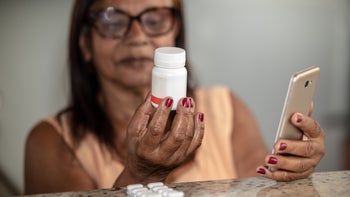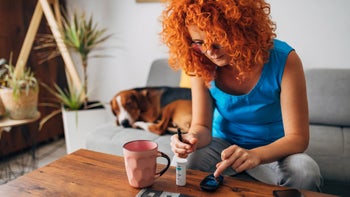
Can Rybelsus Be Taken at Night? Plus, 5 More Pharmacist-Backed Tips for Taking Rybelsus
Key takeaways:
Rybelsus (semaglutide) is an oral glucagon-like peptide-1 (GLP-1) agonist medication. It’s approved to treat Type 2 diabetes in adults.
It’s recommended to take Rybelsus first thing in the morning on an empty stomach. That’s because food, beverages, and other medications can affect its absorption. Wait at least 30 minutes after taking Rybelsus before eating, drinking, or taking other medications.
Some people may not be able to take Rybelsus in the morning due to shift work, fasting, or other reasons. In some cases, you may be able to take Rybelsus at night. Your prescriber can help you figure out a better time that works for you.
There are ways to save on Rybelsus, which is available as a brand-name medication. With a manufacturer copay card, you could pay as little as $10 for Rybelsus.
Table of contents

When you receive your Rybelsus (semaglutide) prescription, there are several important instructions to follow. This includes when to take it and how to time food, drinks, and other medications around your dose. And there are specific storage instructions, too.
All of these recommendations are in place to help you get the most benefit from Rybelsus. But there may be situations where these instructions don’t fit with your schedule due to work or other reasons. In this case, can you take Rybelsus at a different time? We cover this topic and five more below.
1. The best time to take Rybelsus is first thing in the morning on an empty stomach
To get the most benefit from Rybelsus, it’s best to take it on an empty stomach. This is because Rybelsus isn’t absorbed very well. It’s also easily broken down by enzymes in the stomach. Taking it with food can almost completely limit its absorption.
Save over 40% on Qsymia with GoodRx
Discover the once daily Qsymia for weight management. Qsymia is for adults and children 12-17 in combination with a healthy diet and regular exercise.

You’ll absorb more of your Rybelsus dose if you’ve fasted overnight, which is why it’s best to take it first thing in the morning. Make sure to swallow the tablet whole with up to 4 oz (120 mL) of water. Wait at least 30 minutes before eating, drinking, or taking other medications.
2. It may be OK to take Rybelsus at night in certain situations
But what happens if you can’t take Rybelsus in the morning? There may be certain situations where you may be told to take it at a different time, such as at night. It’s best to discuss your situation with your prescriber before adjusting your Rybelsus timing. But here are a few tips to help with your discussion.
Shift work: If you work the night shift, you may need to take Rybelsus later in the day if a morning dose isn’t feasible. The general guidance is to fast at least 6 hours before taking Rybelsus, then wait at least 30 minutes before eating.



Fasting: If you’re fasting from sunrise to sunset for religious reasons, such as during Ramadan, experts recommend taking Rybelsus after sunset. Then, wait 30 minutes before eating the fast-breaking evening meal. Another option is to take Rybelsus at least 30 minutes before your pre-dawn meal, but only if you’ve been fasting at least 6 hours beforehand.
Keep in mind that taking Rybelsus differently from what’s recommended may affect how much you absorb. Your prescriber can monitor your response to treatment and make adjustments as needed.
Good to know: Semaglutide, the main ingredient in Rybelsus, is also available as a weekly injection called Ozempic. If timing your Rybelsus dose is an issue, Ozempic may be an alternative to consider since you can inject it at any time of day.
3. Rybelsus may also affect how you absorb other medications
As mentioned earlier, it’s important to take Rybelsus before any food, drink, or other medications. This is because they can reduce how much Rybelsus you absorb. However, it’s possible for Rybelsus to affect other medications, too. While it’s not a comprehensive list, below are a few examples.
Thyroid medications
One of the ways Rybelsus works is by slowing down how quickly food leaves your stomach. This effect can potentially interfere with how your body absorbs certain oral medications. One example is levothyroxine (Synthroid). When it’s taken with Rybelsus, you may be exposed to greater amounts of levothyroxine.
Rybelsus and levothyroxine are both recommended to be taken first thing in the morning on an empty stomach. So you may need to adjust your dosing schedule to manage this interaction. For example, you may be told to take levothyroxine at night, at least 3 hours after your last meal of the day, instead. Your prescriber may also want to monitor your thyroid levels more frequently.
Bisphosphonates
Another potential Rybelsus interaction is with oral bisphosphonates, such as alendronate (Fosamax). These medications should also be taken first thing in the morning on an empty stomach for best absorption. And taking them at bedtime isn’t recommended. That’s because oral bisphosphonates can damage the esophagus, especially if you lie down after taking them.
In this case, your prescriber may recommend switching to an injectable bisphosphonate, such as ibandronate or zoledronic acid (Reclast). These forms wouldn’t interact with Rybelsus.
4. Don’t crush or cut Rybelsus tablets
Rybelsus normally isn’t absorbed very well. That’s why it’s co-formulated in a specific way with an absorption enhancer called salcaprozate sodium. It’s not known if splitting, crushing, or chewing Rybelsus tablets interferes with this formulation. So it’s recommended to swallow Rybelsus tablets whole.
If you have difficulty swallowing Rybelsus tablets, talk to your prescriber about an alternative. As mentioned earlier, Ozempic may be a pill-free option to consider.
5. There are ways to manage nausea from Rybelsus
One of the most common Rybelsus side effects is nausea, especially when you start treatment and after dose increases. This side effect usually improves over time. But in the meantime, here are a few tips for managing nausea from Rybelsus.
Follow the titration schedule. It’s best to start with a low Rybelsus dose (3 mg), which is then slowly increased on 30-day intervals as directed by your prescriber. This titration schedule helps your body get used to Rybelsus over time to lessen side effects.
Avoid or minimize foods that worsen nausea. Greasy, fatty, and sugary foods; alcohol; and ultra-processed foods can make nausea worse. It’s a good idea to avoid or minimize these foods while taking Rybelsus.
Eat smaller meals. Rybelsus can make you feel full faster. Eating smaller meals throughout the day can help you feel less nauseous after you eat.
6. Store Rybelsus tablets in their original container, not a pill organizer
For Rybelsus to work properly, it’s important to preserve its integrity. That means storing it properly to protect it from heat, light, and moisture, which can affect how well it works.
The manufacturer recommends storing Rybelsus in its original bottle — not a pill organizer or regular prescription bottle. That’s because the Rybelsus bottle’s blue cap is made a certain way to protect the tablets by absorbing moisture. Keep the bottle closed until it’s time for your dose. And put the cap back on right after you take out a tablet.
Keep your Rybelsus bottle in a cool, dry place. For example, you can keep your medication in your dresser drawer, on a shelf, or in a closet. Just make sure it’s out of reach of children and pets. Although tempting, avoid places like the bathroom that tend to get humid.
Keeping your medication in the same spot as other medications can help you to remember to take it. Putting a reminder on your phone in the morning or using one of the many medication reminder apps can also be helpful.
Tips for saving on Rybelsus
There are ways to save on Rybelsus, which is only available as a brand-name medication. If you’re eligible, you could pay as little as $10 for a 30- to 90-day supply of Rybelsus with a manufacturer copay card. You could also get Rybelsus for as little as $0 through a patient assistance program, depending on your eligibility.
The bottom line
Rybelsus (semaglutide) is an oral Type 2 diabetes medication. The best time to take it is in the morning on an empty stomach. Then, wait at least 30 minutes before consuming food, drink, or other medications. But there may be situations, such as shift work or fasting, where you’re told to take Rybelsus at a different time.
Don’t crush, chew, or split Rybelsus tablets. Keep the tablets in their original bottle, since that will help protect them from moisture. Avoid storing Rybelsus in humid environments, such as the bathroom. Instead, select a cool, dry place out of reach of children and pets.
Talk to your healthcare team if you have any questions about taking Rybelsus or changing when you take your dose.
Why trust our experts?



References
Aroda, V. R., et al. (2022). A new era for oral peptides: SNAC and the development of oral semaglutide for the treatment of type 2 diabetes. Reviews in Endocrine and Metabolic Disorders.
Bækdal, T. A., et al. (2021). Effect of various dosing conditions on the pharmacokinetics of oral semaglutide, a human glucagon-like peptide-1 analogue in a tablet formulation. Diabetes Therapy.
Bækdal, T. A., et al. (2021). Relationship between oral semaglutide tablet erosion and pharmacokinetics: A pharmacoscintigraphic study. Clinical Pharmacology in Drug Development.
Brunton, S. A., et al. (2020). Integrating oral semaglutide into clinical practice in primary care: For whom, when, and how? Postgraduate Medicine.
Evans, M., et al. (2022). Meeting the challenge of virtual diabetes care: A consensus viewpoint on the positioning and value of oral semaglutide in routine clinical practice. Diabetes Therapy.
Ganesan, K., et al. (2023). Bisphosphonate. StatPearls.
Hassanein, M., et al. (2022). Recommendations for titration and administration of oral semaglutide for the treatment of type 2 diabetes during Ramadan. Dubai Diabetes and Endocrinology Journal.
Hauge, C., et al. (2021). Effect of oral semaglutide on the pharmacokinetics of thyroxine after dosing of levothyroxine and the influence of co-administered tablets on the pharmacokinetics of oral semaglutide in healthy subjects: An open-label, one-sequence crossover, single-center, multiple-dose, two-part trial. Expert Opinion on Drug Metabolism and Toxicology.
Kalra, S., et al. (2022). Oral semaglutide: Dosage in special situations. Diabetes Therapy.
Medline Plus. (2022). Storing your medicines. National Library of Medicine.
Novo Nordisk. (2017). Rybelsus [package insert].
Van Hout, M., et al. (2023). Effect of various dosing schedules on the pharmacokinetics of oral semaglutide: A randomised trial in healthy subjects. Clinical Pharmacokinetics.
Was this page helpful?
Related Articles
Browse medications
View AllResearch prescriptions and over-the-counter medications from A to Z, compare drug prices, and start saving.
























